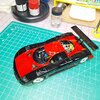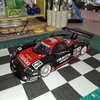What masking tape did you use?
To avoid this in the future:
Never put a masked model in the dehydrator. The prolonged heat, even if mild, will melt itself into the underlying paint, especially if it's gloss, and even more so with Tamiya or Gunze (alcohol solvent) gloss. Apply the paint, let dry to tack-free, then remove the masking before placing it in the dehydrator. You may also have cured the black paint too fast. For long cure times, reduce heat.
I don't think Tamiya or Gunze gloss paints have changed formulation since I last encountered surface problems with them. The problem lies in the gloss, which has (or at least had) a silicone compound that migrates to the surface as the paint cures. Produces a marvelous finish, but can produce problems with masking and paints applied to the gloss surface. What I recommended back then was to use a flat color for the base coat, polish it, then apply the gloss paint over that, and finally apply a clear Tamiya gloss over all. The Tamiya gloss avoids incompatibility issues with the underlying Tamiya paint.







